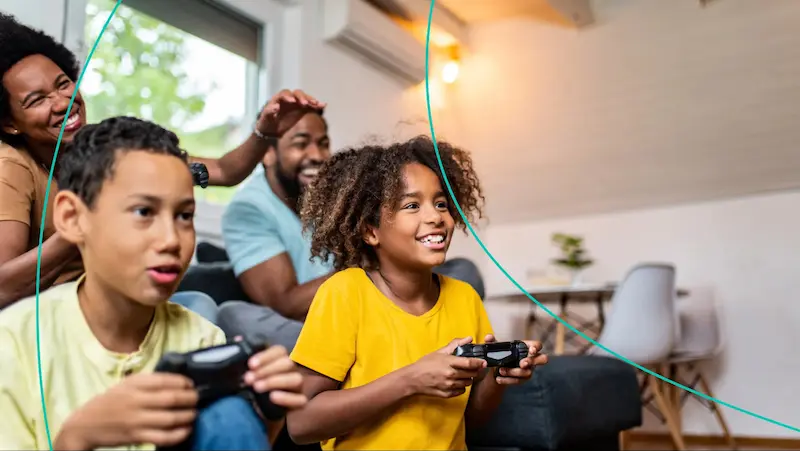Video games have become a ubiquitous form of entertainment in the modern era, captivating the attention and imagination of people of all ages. However, one demographic that has particularly embraced this digital revolution is children.
The popularity and influence of video games among children have grown exponentially over the years, shaping their leisure activities, social interactions, and even cognitive development.
This phenomenon can be attributed to several factors, including technological advancements, the appeal of immersive gameplay experiences, and the emergence of gaming as a mainstream cultural phenomenon. In this discussion, we will explore the reasons behind the rising popularity of video games among children and examine the various ways in which these digital experiences have come to wield significant influence in their lives.
Table of contents
Benefits of Video Games for Kids
Video games have come a long way since their inception, evolving from simple pixelated entertainment to immersive, interactive experiences. While concerns have been raised about the potential negative effects of gaming, research has increasingly highlighted the positive impact video games can have on cognitive skills, problem-solving abilities, and social interactions.
In this blog, we will explore the beneficial effects of video games on these aspects of our lives and shed light on the growing body of evidence supporting their positive influence.

BrightChamps offers free computer games for kids that have a positive influence, promoting valuable skills and useful learning experiences. Join our platform to access a wide range of interactive games that foster creativity, critical thinking, and knowledge in a fun and engaging way. Checkout computer games for kids free.
Enhancing Cognitive Skills
Contrary to the notion that video games are mindless activities, studies have shown that gaming can significantly improve cognitive skills. Fast-paced action games, for example, have been found to enhance attention, reaction time, and spatial awareness. Players often need to process a vast amount of visual and auditory information simultaneously, making split-second decisions and adapting to changing scenarios, which exercises their cognitive abilities.
Additionally, strategy and puzzle games stimulate critical thinking and problem-solving skills. They require players to analyze complex situations, devise strategies, and think creatively to overcome obstacles. These cognitive demands can lead to improved problem-solving abilities and decision-making skills that can be transferred to real-life situations.
Developing Problem-Solving Abilities
Video games often present players with intricate challenges and puzzles, encouraging them to think critically and develop problem-solving abilities. Players must assess the situation, identify patterns, and formulate effective strategies to progress in the game. By engaging in these mental exercises, gamers can enhance their problem-solving skills, pattern recognition, logical reasoning, and lateral thinking.
Moreover, some games incorporate educational elements, allowing players to tackle real-world issues and apply problem-solving skills in various contexts. These games can provide a practical and interactive learning experience that fosters creativity, adaptability, and resilience.
Facilitating Social Interactions
Contrary to the stereotype of gamers as isolated individuals, modern video games offer rich opportunities for social interactions and collaboration. Many games are designed with multiplayer features that enable players to connect with friends or meet new people from around the world. Through online multiplayer platforms, gamers can communicate, strategize, and cooperate to achieve common objectives, fostering teamwork and social skills.
Moreover, some games have vibrant communities where players can share experiences, discuss strategies, and provide mutual support. These interactions not only encourage social bonding but also allow players to develop communication skills, cultural awareness, and empathy as they engage with diverse individuals from different backgrounds and perspectives.
Training Transferable Skills
One of the most intriguing aspects of video games is their potential to develop skills that can be transferred to real-life situations. For example, flight simulator games have been used to train pilots, while driving simulation games have helped improve driving skills. These simulations offer a safe and controlled environment where individuals can practice complex tasks and gain practical experience, potentially leading to enhanced performance in related real-world activities.
Similarly, multiplayer games that require teamwork and coordination can promote skills applicable to professional settings. Effective communication, leadership, collaboration, and problem-solving abilities learned in these games can translate into the workplace, where individuals often face similar challenges.
Choosing Age-Appropriate Games
In today’s digital era, video games have become an increasingly popular form of entertainment. However, not all games are suitable for all age groups. As a responsible consumer and parent, it’s important to understand how to evaluate game content, ratings, and age suitability to make informed decisions.
In this blog, we’ll provide you with valuable tips to help you navigate the world of gaming and ensure that the games you choose are appropriate for yourself or your children.
Familiarize Yourself with Game Ratings
Game ratings are a crucial tool for assessing the age appropriateness and content of a game. Different countries have different rating systems, such as the Entertainment Software Rating Board (ESRB) in the United States, Pan European Game Information (PEGI) in Europe, and the Computer Entertainment Rating Organization (CERO) in Japan.

Familiarize yourself with the rating symbols and definitions to understand what they indicate. These ratings typically include descriptors such as violence, sexual content, language, and substance use.
Read Reviews and Online Discussions
Before purchasing a game, take some time to read reviews and participate in online discussions about it. Gaming communities and forums are great resources for gathering information about a game’s content and suitability.
Reviews from trusted sources or fellow gamers can provide insights into the game’s themes, storylines, and potentially objectionable content. Be sure to consider multiple perspectives to get a well-rounded understanding of the game.
Research Game Content
Game trailers, promotional materials, and gameplay videos can offer glimpses into a game’s content. Watch gameplay footage on platforms like YouTube or Twitch to see the game in action.
Pay attention to the visuals, themes, language, violence, and any other elements that might be important for your evaluation. Developers often release content warnings or advisories, so check if any are provided and take them into account.
Utilize Parental Controls:
Most gaming platforms, such as consoles and PCs, offer parental control features. These allow you to set restrictions on game access, online interactions, and time limits.
Familiarize yourself with the parental control options available and make use of them to tailor the gaming experience to your or your child’s needs. Setting up age-appropriate restrictions can help ensure a safer and more controlled gaming environment.
Seek Recommendations
If you’re unsure about a game’s suitability, don’t hesitate to seek recommendations from friends, family members, or other parents who have similar concerns.
They might have firsthand experience with the game or be able to provide suggestions based on their own evaluations. Online gaming communities or parenting groups can also be valuable resources for gathering recommendations and advice.
Be Aware of Online Interactions
Many games offer online multiplayer features, which can expose players to interactions with other gamers. If you’re considering a game with online capabilities, research the safety features it provides.
Look for games that offer robust chat filters, options to disable or limit interactions, and reporting mechanisms for inappropriate behavior. Encourage open communication with your children about responsible online behavior and the potential risks of interacting with strangers.

Educational Video Games
In the digital age, where screens dominate our daily lives, there is a growing debate about the impact of technology on education. However, amidst the concerns, there lies a world of opportunity: educational games.
These interactive and engaging tools not only capture the attention of learners but also offer a wealth of knowledge across various subjects. In this blog, we will explore the value of educational games and recommend popular titles that can revolutionize the way we learn.
The Power of Educational Games
Educational games have the unique ability to merge entertainment and learning seamlessly. They provide a dynamic learning environment where students can actively participate and engage in the subject matter.
Here are some key benefits they offer:
a) Active Learning: Educational games promote active learning by requiring students to make decisions, solve problems, and think critically. This hands-on approach enhances their understanding and retention of knowledge.
b) Engagement and Motivation: By transforming learning into an enjoyable experience, educational games motivate students to explore and delve deeper into various subjects. They foster curiosity and a thirst for knowledge.
c) Personalized Learning: Many educational games adapt to the learner’s abilities, providing personalized feedback and challenges. This individualized approach helps students progress at their own pace and build confidence.
d) Collaboration and Social Interaction: Certain educational games foster collaboration and social interaction, allowing students to work together, solve puzzles, and learn from one another. This promotes teamwork and enhances communication skills.
Recommended Educational Games
Now that we understand the value of educational games, let’s explore popular titles across different subjects that can captivate learners of all ages:
a) Math: “Prodigy,” an immersive math game, combines role-playing elements with math problems, making learning arithmetic enjoyable and engaging. “Mathletics” offers comprehensive math curriculum support and interactive activities for students of all grades.
b) Science: “Minecraft: Education Edition” lets students explore virtual worlds, conduct experiments, and learn about biology, geology, and more. “The Magic School Bus: Oceans” provides an interactive adventure to explore marine biology concepts.
c) History: “Civilization VI” allows students to build and manage civilizations while learning about historical events, cultures, and leaders. “Assassin’s Creed: Origins” features a historically accurate setting in ancient Egypt, bringing history to life.
d) Language Arts: “Reader Rabbit” offers a range of games and activities to improve reading and language skills for young learners. “WordGirl” provides vocabulary-building exercises and challenges in a superhero-themed environment.
e) Geography: “GeoGuessr” is a fun game for kids that tests students’ knowledge of geography by dropping them into random locations around the world. “National Geographic Kids” offers interactive games, quizzes, and videos to explore the world’s wonders.
Integrating Educational Games in the Classroom
To maximize the benefits of educational games, it is essential to integrate them effectively into the classroom.
Here are a few strategies:
a) Align with Curriculum: Select educational games that align with the curriculum to ensure relevance and reinforce learning objectives.
b) Supplement Traditional Teaching: Use educational games as supplementary tools to reinforce concepts taught in the classroom. They can serve as valuable practice exercises or review activities.
c) Gamify Learning: Incorporate game-based elements into lessons, such as leaderboards, badges, and rewards, to motivate students and create a competitive yet supportive learning environment.
d) Monitor Progress: Many educational games provide progress reports and analytics. Monitor student performance to identify areas of improvement and provide targeted support.
Safety Considerations
The digital age has brought about numerous opportunities for learning, communication, and entertainment. However, it has also given rise to concerns regarding online safety, especially for young individuals.
As technology continues to evolve, it becomes essential for both parents and guardians to understand and implement effective online safety measures, utilize parental controls, and foster responsible gaming habits.
This blog aims to explore these topics, providing valuable insights and practical tips to create a safer and more responsible digital environment for all.

Online Safety Measures:
Ensuring online safety is crucial in protecting individuals from potential risks and threats. Here are some essential measures to consider:
a) Education and Communication: Openly discuss online safety with children and teenagers, teaching them about potential dangers, cyberbullying, and the importance of privacy. Encourage them to share their online experiences, report any concerns, and seek guidance when needed.
b) Strong Passwords and Privacy Settings: Emphasize the significance of creating strong, unique passwords and enabling privacy settings on social media platforms and other online services. Regularly remind children to never share personal information online without adult supervision.
c) Responsible Social Media Usage: Teach children to think before sharing or posting any content online. Encourage them to be mindful of their digital footprint and to be cautious about accepting friend requests or engaging with unknown individuals.
d) Internet Filtering and Antivirus Software: Utilize reliable internet filtering tools and antivirus software to protect against malicious websites, malware, and other online threats. These tools can help safeguard children from accessing inappropriate content or falling victim to scams.
Parental Controls:
Parental controls play a vital role in supervising and managing a child’s online activities.
Here are some key steps to implement effective parental controls:
a) Device Monitoring: Set up parental controls on smartphones, tablets, computers, and gaming consoles. These controls can limit access to age-inappropriate content and track online activities, providing insights into a child’s digital behavior.
b) Content Restrictions: Utilize content filtering tools and software to block or restrict access to inappropriate websites, apps, or games. Set age-appropriate restrictions to ensure a safe and enriching digital experience.
c) Screen Time Management: Implement screen time limits to strike a healthy balance between online and offline activities. Encourage alternative hobbies, physical exercise, and face-to-face social interactions to promote overall well-being.
d) Regular Check-ins: Maintain open lines of communication with your children and periodically review their online activities. Address any concerns, answer questions, and provide guidance on responsible online behavior.
Responsible Gaming Habits:
Gaming is a popular form of entertainment, but it is essential to instill responsible gaming habits.
Here are some suggestions:
a) Age Ratings and Content: Familiarize yourself with game ratings and content descriptors. Select games appropriate for your child’s age and maturity level, considering factors such as violence, language, and online interactions.
b) Set Time Limits: Establish clear rules on gaming time and ensure it does not interfere with other important activities like schoolwork, physical exercise, or family time. Encourage breaks during extended gaming sessions.
c) Online Interactions: Teach children about online etiquette and respectful behavior while gaming. Emphasize the importance of not sharing personal information or engaging in toxic or abusive interactions with other players.
d) Lead by Example: Be a positive role model by demonstrating responsible gaming habits yourself. Show moderation, engage in diverse activities, and prioritize a healthy and balanced lifestyle.
Managing Screen Time
In today’s digital age, screens have become an integral part of our lives. We use them for work, entertainment, communication, and more. However, excessive screen time can have detrimental effects on our physical and mental well-being.
It’s crucial to establish healthy boundaries and strike a balance between screen use and other aspects of life. In this blog, we will provide practical guidelines for setting limits on screen time and maintaining a healthy balance.

Assess Individual Needs
Recognize that each person has unique requirements and circumstances when it comes to screen time. Consider factors such as age, responsibilities, and personal goals.
For example, a teenager may need more screen time for educational purposes, while an adult might prioritize work-related screen usage. Assessing individual needs is the first step toward creating effective guidelines.
Define Purposeful Screen Time
Encourage purposeful and meaningful screen time activities. Distinguish between productive screen use and mindless scrolling. Engaging in educational pursuits, creative endeavors, or connecting with loved ones through video calls can contribute positively. Establish a clear distinction between valuable screen time and activities that offer little benefit.
Set Clear Boundaries
Establish specific rules and boundaries for screen time. Decide on time limits for different activities such as work, leisure, and social media. Communicate these guidelines openly with family members or roommates to foster a shared understanding and mutual accountability. Consistency is key to establishing healthy habits.
Create Tech-Free Zones and Times
Designate certain areas or periods as tech-free zones. For example, establish screen-free zones at the dining table, during family gatherings, or before bedtime. These boundaries help create opportunities for face-to-face interactions, quality sleep, and relaxation without constant digital distractions.
Encourage Physical Activity and Outdoor Time
Promote a balanced lifestyle by emphasizing the importance of physical activity and spending time outdoors. Encourage activities such as exercise, sports, hobbies, and exploring nature. Encouraging these alternatives can help reduce excessive screen time and promote overall well-being.
Lead by Example
As adults, it’s essential to lead by example. Children and teenagers often model their behavior based on what they observe from adults. Strive to limit your own screen time and prioritize face-to-face interactions, outdoor activities, and pursuing hobbies. By demonstrating a healthy balance, you encourage others to do the same.
Utilize Screen Time Management Tools
Take advantage of the various screen time management tools available. Both smartphones and computers offer built-in features that allow you to set screen time limits, block certain apps or websites, and track your usage. Use these tools to assist you in adhering to your established guidelines.
Engage in Alternative Activities
Encourage engaging activities that do not involve screens. Encourage reading books, playing board games, pursuing creative projects, or engaging in hobbies such as painting, gardening, or playing a musical instrument. By diversifying leisure activities, individuals can find fulfillment beyond screens.
Impact on Child Development
Video games have become a prominent form of entertainment in today’s digital age. While concerns about their potential negative effects on children persist, it is important to recognize that video games can also offer numerous psychological and developmental benefits.
As parents and educators, understanding these advantages is crucial in order to make informed decisions about the role of video games in children’s lives. In this blog, we will explore some of the positive effects that video games can have on kids’ psychological well-being and overall development.

Enhancement of Cognitive Skills
Video games often require players to think critically, solve problems, and make strategic decisions. These mental challenges can lead to the development of cognitive skills such as problem-solving, spatial awareness, memory retention, and multitasking abilities.
For example, puzzle-based games encourage logical thinking and problem-solving, while action games demand quick decision-making and reflexes. These cognitive benefits can extend beyond the virtual world and have a positive impact on academic performance and real-life problem-solving abilities.
Improvement in Social Skills
Contrary to the stereotype of video games isolating children, many games today offer robust multiplayer modes that foster social interaction and cooperation. Online gaming platforms provide opportunities for kids to connect with friends and make new ones, promoting teamwork, communication, and collaboration.
Cooperative gameplay requires players to work together towards a common goal, fostering important social skills such as empathy, cooperation, and leadership. Furthermore, video games can act as a catalyst for forming friendships and creating social bonds, particularly when shared interests and passions align.
Enhanced Focus and Attention
Engaging in video games often demands sustained focus and attention to navigate complex virtual environments. This can have a positive impact on a child’s ability to concentrate and remain focused for extended periods, a skill that translates to various aspects of their lives, including academic pursuits.
Additionally, research suggests that action video games, such as those involving fast-paced gameplay and high visual stimuli, can enhance visual attention and spatial awareness. These benefits can contribute to improved concentration, reaction time, and multitasking abilities.
Stress Relief and Emotional Regulation
Video games can serve as a healthy outlet for stress relief and emotional regulation in children. Engaging in gameplay provides an immersive and interactive experience that allows kids to temporarily escape from real-life pressures and challenges.
The sense of achievement and progression within a game can boost self-esteem and confidence, providing a positive emotional experience. Moreover, certain game genres, such as relaxation or mindfulness games, are specifically designed to promote relaxation, stress reduction, and emotional well-being.
Encouragement of Creativity
Many video games today offer creative tools and sandbox environments that allow children to express their imagination and creativity. Games with level editors or character customization features encourage kids to think creatively and design unique experiences.
This can stimulate artistic expression, problem-solving, and critical thinking skills. Furthermore, the rise of educational games and game-based learning platforms enables children to engage in interactive and immersive experiences that foster creativity in areas such as mathematics, science, and storytelling.
Also, computer programming for kids through a variety of interesting and interactive games, creating a fun and engaging way to learn coding.
Kid-Friendly Gaming Consoles
In recent years, the world of gaming has expanded to include a range of consoles specifically designed for children. These consoles not only offer a fun and entertaining gaming experience but also prioritize safety and age-appropriate content.
In this blog, we will explore some of the top gaming consoles tailored for young gamers and delve into their unique features and benefits.

Nintendo Switch
The Nintendo Switch is a versatile gaming console loved by children and adults alike. Its unique selling point lies in its ability to seamlessly switch between handheld and docked modes, providing flexibility and convenience.
The console offers a wide range of child-friendly games featuring beloved characters like Mario, Pikachu, and Link from “The Legend of Zelda” series. With parental controls, you can manage screen time, restrict access to certain content, and set playtime limits, ensuring a safe and controlled gaming environment for children.
LeapFrog LeapTV
LeapFrog LeapTV is an educational gaming console designed specifically for younger children (ages 3 to 8). It combines physical activity with interactive learning games, fostering both mental and physical development. The console comes with a motion-sensing camera and a controller specifically designed for small hands.
LeapTV offers a wide range of age-appropriate games that cover various subjects, including math, science, reading, and problem-solving. The emphasis on education makes LeapTV an excellent choice for parents who want their children to engage in constructive gaming experiences.
Xbox Series S
The Xbox Series S is a more advanced gaming console suitable for older children and teenagers. While it offers a vast library of games suitable for all age groups, its features specifically designed for younger gamers make it an attractive choice.
The Xbox Family Settings app allows parents to set screen time limits, manage online interactions, and ensure the content is age-appropriate. The Xbox Game Pass subscription service provides access to a wide variety of games, including many child-friendly titles, ensuring a constant stream of entertainment options.
PlayStation 5 (PS5)
The PlayStation 5 is a high-performance gaming console that also offers options for younger players. The PS5 features an intuitive user interface, making it easy for children to navigate.
With its extensive library of games, including popular titles like “Ratchet & Clank: Rift Apart” and “Astro’s Playroom,” children can enjoy immersive and age-appropriate gaming experiences. The console also offers parental controls, enabling guardians to manage screen time, restrict access to certain features, and monitor online interactions.
Ensuring Online Safety
In today’s digital era, where technology plays an integral role in our lives, it is essential to prioritize the safety of our children in their online activities. As gaming continues to gain popularity among young people, it is crucial to implement strategies that protect them from online threats while fostering a safe and enjoyable gaming environment.
This blog will discuss effective strategies for safeguarding children from online risks and creating a positive gaming experience.

Education and Communication
The foundation for protecting children from online threats starts with education and open communication. Parents should educate themselves about online risks and understand the platforms their children are using.
Engage in regular conversations about online safety, emphasizing the importance of responsible gaming behavior, respectful communication, and the potential dangers of sharing personal information with strangers. Encourage children to report any suspicious or uncomfortable encounters while gaming.
Setting Appropriate Boundaries
Establishing clear boundaries is vital to creating a safe gaming environment. Set limits on screen time and define specific rules for gaming activities.
Ensure that children understand the importance of taking breaks, balancing gaming with other activities, and respecting family rules. Utilize parental control features provided by gaming consoles, online platforms, and third-party applications to regulate access to age-appropriate content and limit interactions with strangers.
Choosing Age-Appropriate Games
Parents should carefully select age-appropriate online games for kids. Look for gaming content with appropriate ratings and descriptions that align with the child’s maturity level. Research games beforehand to determine if they contain any violent or explicit content. Encourage the use of educational games that promote skill development, critical thinking, and creativity. Monitor and periodically review the games your child plays to ensure they remain suitable.
Engage in Co-Play and Co-Viewing
Participating in co-play and co-viewing experiences allows parents to be actively involved in their child’s gaming activities. Play games together and show interest in your child’s gaming experiences.
This involvement helps foster a sense of trust, provides opportunities for open discussions about online safety, and allows parents to assess the content and interactions within the game. By engaging in shared gaming experiences, parents can better understand potential risks and address them proactively.
Enable Safe Online Interactions
Many online games allow players to communicate with others. Ensure that your child understands the importance of appropriate behavior and respectful communication while gaming. Teach them to avoid sharing personal information such as full name, address, phone number, or school details.
Encourage the use of game-specific usernames rather than revealing real names. Remind children to report any instances of cyberbullying, harassment, or inappropriate behavior to the game’s moderation team or to you as a parent.
Stay Informed About Privacy Settings
Familiarize yourself with the privacy settings available on gaming platforms and educate your child about their importance. Review and adjust these settings regularly to ensure the highest level of privacy and security.
Teach children about the risks associated with accepting friend requests or engaging in private chats with strangers. Encourage them to only interact with people they know in real life and reinforce the importance of not sharing personal information online.
Resources for Parents
In today’s digital era, video games have become an integral part of many children’s lives. As a parent, it’s important to stay informed about the latest video game trends, understand their content, and make informed decisions about what games are suitable for your child.
Thankfully, there are numerous online resources available that provide valuable information and updates specifically catered to parents. In this blog, we will highlight some helpful websites, forums, and blogs that will assist you in navigating the world of video games and keeping up with the latest trends for kids.

Common Sense Media
Common Sense Media is a comprehensive website that provides parents with detailed reviews and ratings for various media, including video games. Their video game section covers a wide range of platforms, genres, and age ratings, allowing you to make informed decisions about which games are appropriate for your child.
Entertainment Software Rating Board (ESRB)
ESRB is a well-known rating system for video games in North America. Their website offers detailed information about game ratings, content descriptors, and interactive tools to help parents understand the suitability of games for their children. You can search for specific game titles, view rating summaries, and access valuable resources for family discussions about gaming.
Reddit r/Parenting
Reddit’s r/Parenting community provides a platform for parents to discuss various parenting topics, including video games. Here, you can find threads dedicated to video game trends, recommendations, and concerns specific to children. Engaging with other parents in the community can provide a wealth of insights and perspectives on managing your child’s gaming habits.
Parenting Gamers
Parenting Gamers is a blog dedicated to providing parents with practical advice, resources, and insights into raising children who love video games. The blog covers topics such as setting boundaries, balancing screen time, and understanding the positive aspects of gaming. They also offer game reviews, tips for choosing age-appropriate games, and guidance on gaming-related issues.
Common Sense Media’s YouTube Channel
In addition to their website, Common Sense Media maintains an active YouTube channel where they upload video reviews, recommendations, and discussions related to video games. Their engaging video content can be a valuable resource for parents who prefer visual content or want to explore gaming topics in a different format.
The Game Changers by Children and Screens
Children and Screens is an organization focused on understanding and addressing the impact of digital media on children. Their blog section, “The Game Changers,” covers a wide range of topics related to video games, including gaming trends, research findings, and expert opinions. This blog serves as a valuable source of up-to-date information for parents interested in the intersection of children and video games.
Conclusion
In conclusion, when it comes to choosing video games for our children like robotics for kids, it is essential for parents to make informed decisions. By considering key points such as age-appropriateness, content, educational value, and the impact on social and emotional development, parents can ensure that their children engage in healthy and beneficial gaming experiences.
Firstly, parents should pay attention to the age recommendations provided by game developers and rating organizations. These guidelines can help determine whether a game is suitable for a child’s cognitive and emotional development. It is important to consider the complexity of the game mechanics, as well as the potential exposure to violence, explicit language, or other mature themes.
Additionally, examining the content of the game is crucial. Parents should assess whether the game promotes positive values, encourages critical thinking, problem-solving skills, creativity, and cooperation. Games that incorporate educational elements or require strategic thinking can offer valuable learning opportunities for children.
Lastly, staying informed about the latest trends and developments in the gaming industry can help parents make more informed choices. Researching reviews, consulting with other parents, and utilizing online resources can provide valuable insights into the quality and appropriateness of different games.
By considering these key points, parents can empower themselves to make responsible decisions when selecting video games for their children. By striking a balance between entertainment and educational value, parents can ensure that gaming becomes a positive and enriching experience for their children, fostering their overall development and well-being.
BrightChamps provides a variety of useful games for kids on computer that not only improve their skills but also help reduce stress while facilitating continuous learning. Join our platform to explore a world of educational and enjoyable gaming experiences that support your child’s growth and development! To get your hands on more such educational and free resources on coding for kids, robotics courses for kids, game development, etc., do check out the Brightchamps Blog Page now!
Frequently Asked Questions
A1: Video games can enhance problem-solving skills, improve hand-eye coordination, foster creativity, and promote social interaction.
A2: Consider checking the game’s age rating, reading reviews, and understanding the content and gameplay to ensure it aligns with your child’s age and maturity level.
A3: Yes, there are educational video games that cover various subjects, such as math, science, language, and critical thinking.
A4: Parents should set parental controls, monitor online interactions, teach responsible gaming habits, and educate their children about online safety.
A5: The American Academy of Pediatrics recommends limiting screen time to 1-2 hours per day for recreational activities, including video games.
A6: Yes, video games can improve cognitive skills, problem-solving abilities, coordination, and provide opportunities for social interaction and teamwork.
A7: Yes, there are gaming consoles available that are designed with child-friendly features and content, ensuring a safe and enjoyable gaming experience.
A8: Popular video games suitable for young children include “Minecraft,” “Super Mario Odyssey,” “LEGO games,” and “Animal Crossing: New Horizons.”
A9: Ensure your child understands online safety rules, use parental controls and privacy settings, supervise their online activities, and teach them about the risks of sharing personal information.
A10: Websites, blogs, and online communities dedicated to parenting and gaming can provide valuable information and insights on the latest video game trends for kids.

 We are an army of educators and passionate learners from BrightChamps family, committed to providing free learning resources to kids, parents & students.
We are an army of educators and passionate learners from BrightChamps family, committed to providing free learning resources to kids, parents & students.








